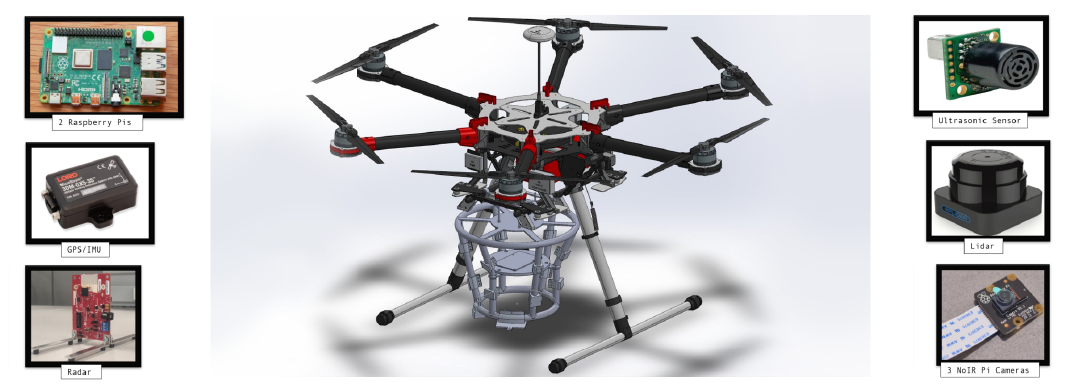Design of Smart Sensor Pallet for Drones
Faculty:
Xiaojun (Ashley) Geng, Electrical and Computer Engineering
Collaborator – September 2019 — May 2020:
Shaun Mcwherter: primary NASA Armstrong contact, and directly involved in the work
Collaborators January-May 2021:
John Lenko: Collaborator from Xtensor Systems Inc., and directly involved in the work
Kurt Vanlaar: Collaborator from Xtensor Systems Inc. and directly involved in the work
Student Team
- Caleb Amposta
- Alejandro Carmona
- Mario Chang
- Thomas Decker*
- Kevin Erazo*
- Marian Giron
- Yasmine Goudjil
- Haroutun Haroutunian*
- Mohammad Hossain*
- Robert Javier*
- Ilker Loza*
- Francisco Maldonado
- Flavio Mendez*
- Najmeh Najmi*
- Haley Nanas*
- Stephen Oonk
- Nathan Speer*
- Ridge Tejuco
- Oscar Tejeda
- Khanh Tran*
* Current Students
Funding
- Funding Organization: NASA
- Funding Program: MIRO
To support NASA missions, NASA scientists and researchers need to test and deploy their newly developed algorithms and sensors on unmanned aerial vehicles (UAVs). Low-cost commercial UAVs are usually closed systems where users cannot modify or use the sensor data for testing or verifying algorithms. To close this gap, Dr. Geng collaborates with Mr. McWherter from NASA Armstrong to develop a modular and reconfigurable pallet. The pallet can be adjusted to fit onto common form-factor drones and be customized with different sensors. Also, the pallet will work as a standalone system with sensor data acquisition and processing capability.

Alignment, Engagement and Contributions to the priorities of NASA’s Mission Directorates
Both NASA and the National Research Council (NRC) have concluded that existing test and evaluation methods are insufficient for advanced AI systems, and have called for R&D of innovative tools and methods to provide guaranteed behavior in unpredictable civil aviation contexts. While future autonomous systems are needed with higher degrees of autonomy, to fly safely in the National Air Space (NAS) and allow for Urban Air Mobility (UAM) requires certifiable software and, importantly, methods that allow for testing and validating software. This project responds to this demand by providing design of modular and customizable pallets, so that complex and new sensor perception and cognition algorithms can be tested and validated instantly on low-cost common form-factor UAVs. The resulting smart pallet concept advances at least the following state-of-the-art areas as requested by NASA: (1) certification process for complex non-deterministic algorithms and (2) sensors and sensor fusion algorithms.
Research Questions and Research Objectives
The research questions involved in this project include:
- How can we ensure the reliability of sensed data and certify new sensors?
- How can we verify the predictivity of sensory perception and cognition algorithms based on Artificial Intelligence and Machine Learning which are based on probability?
- Simulation environments and evaluation tools are insufficient and limited to validate advanced complex probability-based algorithms on sensor fusions; how could these algorithms be certified effectively and economically?
This smart pallet project aims to tackle these questions with the following research objectives:
- Design a portable and reconfigurable pallet for easy customization to common commercial drones;
- Design a plug-and-playable software system for sensor data acquisition on pallet, which will work for most sensors available on the market as well as for future emerging sensors;
- With the designed pallet system, produce publicly accessible real fight sensor data for validating algorithms and developing a more realistic simulation environment;
Research Methods
Currently we are working on the first stage of developing data acquisition software for different sensors (cameras, Lidar, IMUs, etc.). Next stage is to design the mechanical part of the pallet and to integrate together the mechanical and electrical components. After that, we plan to implement sensor fusion algorithms based on artificial intelligence on our smart pallet to enhance NASA UAS perception and cognition. The goal is to demonstrate how intelligence and sensor fusion can be embedded as a small form factor algorithm on a Raspberry PI rather than a PC. This technology will instantly enable NASA researchers to test and deploy their own algorithms and sensors on any type of commercial drones, without purchasing and customizing expensive UAVs.
Research Deliverables and Products
Ultimately, the project will result in the following deliverables:
- A proof of concept demonstration of pallet system, including both hardware and software;
- Publicly accessible real fight sensor data for validating algorithms and developing a more realistic simulation environment; and
- Conference publications and presentations to IEEE automatic control conference or IEEE control and decision conference.
In Fall 2020, a written report and an oral presentation have been generated about the project activities and progress.
Research Timeline
Start Date: January – May 2020
End Date:
Faculty:
Xiaojun (Ashley) Geng, Electrical and Computer Engineering
Collaborator – September 2019 — May 2020:
Shaun Mcwherter: primary NASA Armstrong contact, and directly involved in the work
Collaborators January-May 2021:
John Lenko: Collaborator from Xtensor Systems Inc., and directly involved in the work
Kurt Vanlaar: Collaborator from Xtensor Systems Inc. and directly involved in the work
Student Team
- Caleb Amposta
- Alejandro Carmona
- Mario Chang
- Thomas Decker*
- Kevin Erazo*
- Marian Giron
- Yasmine Goudjil
- Haroutun Haroutunian*
- Mohammad Hossain*
- Robert Javier*
- Ilker Loza*
- Francisco Maldonado
- Flavio Mendez*
- Najmeh Najmi*
- Haley Nanas*
- Stephen Oonk
- Nathan Speer*
- Ridge Tejuco
- Oscar Tejeda
- Khanh Tran*
* Current Students
Funding
- Funding Organization: NASA
- Funding Program: MIRO
